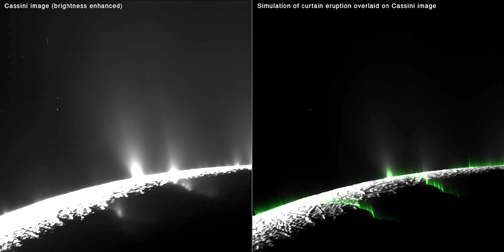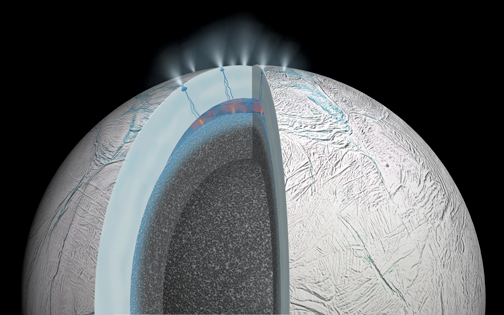
A picture from Cassini of the icy plume eruptions, left and with an overlay to show how it would appear to the eye.
By Charly SHELTON
The Cassini Solstice mission to Saturn that launched in 1997 and arrived in 2004 is about to make history. Yesterday, the spacecraft made a close approach to the surface of Saturnian moon Enceladus. And while Cassini has flown closer to the surface before, it has never flown this close through the icy plume which sprays out into space from the southern pole.
Enceladus has a liquid water ocean which circles the small moon underneath the icy surface shell, about 25 miles thick. The ocean underneath, it is believed, is treated by geothermal heat at the south pole and this causes the water and ice to erupt as ice particles and water vapor, carrying organic compunds with it. The eruption carries the water, ice and organic compounds into space where they are caught in Saturn’s gravity and help to replenish a small ring on the outer edge of Saturn’s great rings, called the E-ring.

Cassini made a dive into the plume Wednesday and passed within 30 miles of the surface, clocking approximately 19,014 miles per hour, relative to Enceladus. The array of instruments captured as much material as possible and over the next few months will be analyzed for several factors, one of which being the presence and composition of the organic compounds. While not indicitave of life itself, it could help to point the way in discerning habitability – the possibility that this moon could support some kind of life. This flyby will not detect the existence of life, as Cassini is not equipped for this. It will, however, be able to tell something about how habitable the envirnment is in the seas beneath the ice.
Another aspect the team hopes to research from the data is evidence of hydrothermal activity, or how the rocky bottom of the planet interacts with the water of the oceans and the internal heat of the moon.
At press time, no information is available from Cassini, other than that the pass was successful and the data will be analyyzed by the team at JPL/NASA.
For more information on the Cassini Solstice mission or the Enceladus flyby, visit Saturn.JPL.NASA.gov. And check with CVWeekly for future stories as more information is relayed back from
Saturn.
